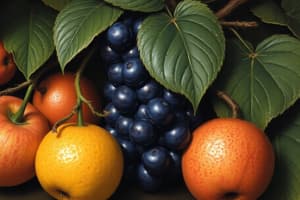Podcast
Questions and Answers
What is a simple fruit?
What is a simple fruit?
One fruit that has developed from one single flower.
What does fleshy mean in the context of fruits?
What does fleshy mean in the context of fruits?
Mesocarp is at least partly fleshy at maturity.
What are pomes?
What are pomes?
Simple fleshy fruit, the bulk of whose flesh comes from the enlarged floral tube or receptacle that grows up around the ovary.
Which of the following fruits are considered pomes? (Select all that apply)
Which of the following fruits are considered pomes? (Select all that apply)
What defines a drupe?
What defines a drupe?
Which fruit types are classified as drupes? (Select all that apply)
Which fruit types are classified as drupes? (Select all that apply)
What are true berries?
What are true berries?
Which of the following are true berries? (Select all that apply)
Which of the following are true berries? (Select all that apply)
What are pepos?
What are pepos?
Which of the following fruits are categorized as pepos? (Select all that apply)
Which of the following fruits are categorized as pepos? (Select all that apply)
What defines a hesperidium?
What defines a hesperidium?
Which fruits are classified as hesperidia? (Select all that apply)
Which fruits are classified as hesperidia? (Select all that apply)
What does indehiscent mean in fruit classification?
What does indehiscent mean in fruit classification?
Which of the following fruits are classified as indehiscent? (Select all that apply)
Which of the following fruits are classified as indehiscent? (Select all that apply)
Flashcards are hidden until you start studying
Study Notes
Fruit Classification Overview
- Fruits can be classified based on their structure and origin, with simple fruits developing from a single flower.
- Types of fruits include fleshy fruits, dry fruits, and variations within these categories.
Simple Fruits
- Simple fruits arise from one ovary of a single flower.
Fleshy Fruits
- Characterized by a mesocarp that is partly fleshy at maturity.
Pomes
- A type of simple fleshy fruit where most flesh comes from an expanded floral tube or receptacle.
- Typically have thick skin and usually contain five seeds.
- Examples: apples, pears, quinces.
Drupes
- Simple fleshy fruits with a single seed enclosed by a hard endocarp (pit) and possess thin skin.
- Notable examples: mangoes, coconuts, cherries, apricots, almonds, olives, peaches, and plums.
Berries
- These fruits develop from a compound ovary and often contain multiple seeds.
True Berries
- A classification of berries that includes all varieties with soft pericarp.
- Examples: tomatoes, grapes, persimmons, peppers, and eggplants.
Pepos
- These fruits have relatively thick rinds.
- Common in the pumpkin family (Cucurbitaceae) with examples including pumpkins, cucumbers, watermelons, squash, and cantaloupes.
Hesperidia
- Fruit with a leathery skin rich in oils, characteristic of the citrus family (Rutaceae).
- Examples include oranges, lemons, limes, grapefruits, tangerines, and kumquats.
Dry Fruits
- Defined by a mesocarp that is dry at maturity.
- Includes dehiscent fruits, which split at maturity, and indehiscent fruits, which do not.
Dehiscent Fruits
- Split open at maturity to release seeds.
- Types include:
- Follicles: Split along one side; examples are larkspur, columbine, and peony.
- Legumes: Split along two sides; examples include erythrina, beans, lentils, carob, and mesquite.
- Siliques: Similar to legumes but the seeds are borne on a central partition; mustard family representatives are broccoli, cabbage, radish, and watercress.
- Capsules: Common type with multiple methods of splitting; examples are iris, orchids, lilies, poppies, violets, and snapdragon.
Indehiscent Fruits
- These fruits do not split upon maturity, and the seed is attached to the pericarp.
- Types include:
- Achenes: Where the seed base is attached to the pericarp; examples are sunflower seeds, buttercup, and buckwheat.
- Nuts: One-seeded fruits that are larger and have a hard, thick pericarp; include acorns, hazelnuts, and hickory nuts.
- Grains: Characterized by a tightly united pericarp with the seed.
Studying That Suits You
Use AI to generate personalized quizzes and flashcards to suit your learning preferences.




